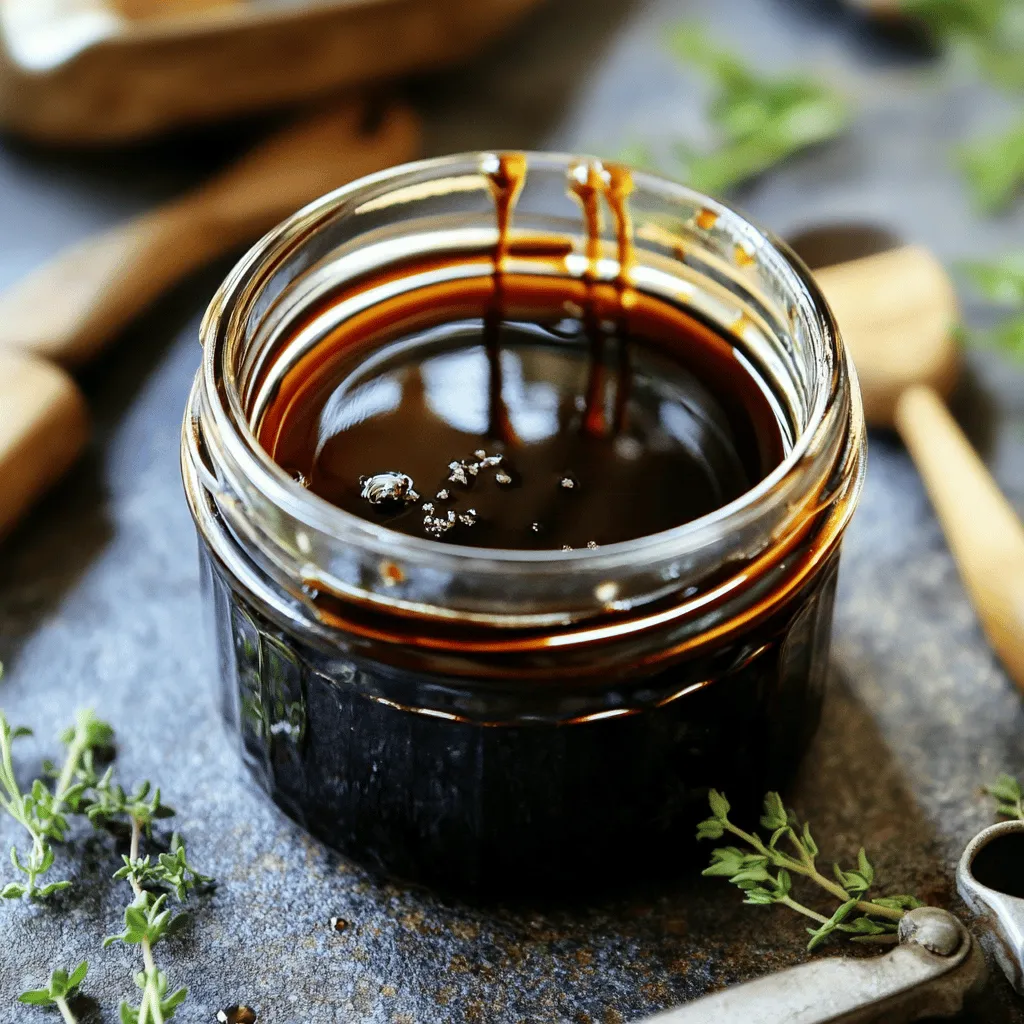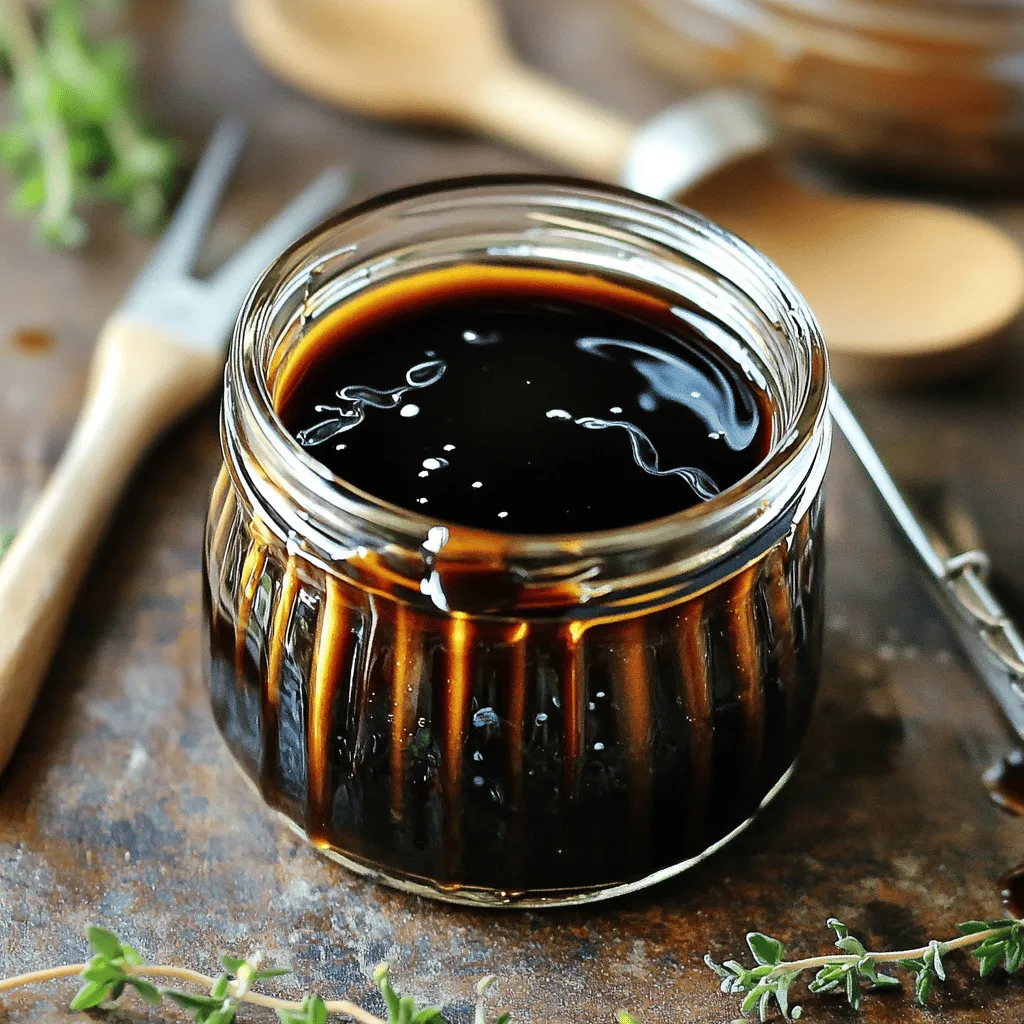If you crave a simple yet delicious addition to your meals, look no further! This Easy Balsamic Glaze recipe will transform your dishes with just a few ingredients. In under 20 minutes, you’ll have a rich, flavorful glaze that pairs well with meats, veggies, and even desserts. Let’s dive into the ingredients and steps to whip up this tasty glaze, perfect for any home cook!
Ingredients
Main Ingredients List
– 1 cup balsamic vinegar
– 1/4 cup brown sugar
– 1 tablespoon Dijon mustard
– 1 teaspoon garlic powder
– 1/2 teaspoon black pepper
– Pinch of salt
– 1 tablespoon olive oil (optional)
To make a delicious balsamic glaze, you need just a few key items. Balsamic vinegar gives the glaze its rich flavor. Brown sugar adds sweetness that balances the tang. Dijon mustard offers a hint of spice. Garlic powder enhances the taste without overpowering it. Black pepper and salt bring out the other flavors. If you want a richer glaze, you can add olive oil.
Optional Ingredients for Variations
– Honey or maple syrup for sweetness
– Fresh herbs for added flavor
– Citrus zest for brightness
You can play with the recipe by adding optional ingredients. Honey or maple syrup can boost the sweetness. Fresh herbs like basil or thyme can add freshness and depth. A bit of citrus zest from lemon or orange can brighten up the flavor. Feel free to get creative! You can find the full recipe in the article.
Step-by-Step Instructions
Preparing the Mixture
First, grab a medium saucepan. Pour in 1 cup of balsamic vinegar and 1/4 cup of brown sugar. Stir until the sugar dissolves. This mix gives the glaze its sweet and tangy flavor. Next, add 1 tablespoon of Dijon mustard, 1 teaspoon of garlic powder, 1/2 teaspoon of black pepper, and a pinch of salt. Whisk everything together until it blends well. This step adds depth to the glaze.
Cooking the Glaze
Now, place the saucepan over medium heat. Bring the mixture to a gentle boil. Stir it occasionally to prevent sticking. Once it starts boiling, reduce the heat to low. Let it simmer for about 15 to 20 minutes. You want it to thicken into a syrupy consistency. This slow cooking makes the flavors richer and more complex.
Final Touches
If you like a richer glaze, stir in 1 tablespoon of olive oil after it thickens. This step is optional but adds great taste. Once you mix in the oil, remove the saucepan from the heat. Let the glaze cool slightly. Finally, transfer it to a jar or airtight container for storage. You can use this homemade balsamic glaze on grilled meats, roasted veggies, or salads. Enjoy your tasty creation! For a complete guide, check the Full Recipe.
Tips & Tricks
Techniques for Perfecting Your Glaze
To make the best balsamic glaze, start by ensuring the sugar is fully dissolved before heating. If you skip this step, the sugar may clump. Stir the mixture well until it blends nicely.
Next, monitor the temperature closely to avoid burning. The glaze should simmer gently. If it boils too hard, it can turn bitter. Keep a watchful eye as it thickens into a rich syrup.
Helping Ingredients
You can experiment with alternative sweeteners. Honey or maple syrup can add unique flavors. Each sweetener will change the glaze’s taste. Try them out to find your favorite.
Choosing the right balsamic vinegar is key. A high-quality balsamic will yield a better glaze. Look for one that is aged and thick. This will give your glaze depth and richness.
Enhancing Flavor
To enhance your glaze, consider adding herbs and spices. Fresh rosemary or thyme can bring a new dimension. A pinch of chili flakes adds heat if you like spice.
Balancing sweetness and acidity is essential. Taste as you go, adjusting to your liking. If it’s too sweet, add a splash of vinegar to brighten it up. This balance is what makes your glaze truly shine.
For the full recipe, check out the detailed steps above.

Variations
Flavorful Additions
You can make your balsamic glaze even better! Try adding fruit like strawberries or figs. These fruits add a sweet and fresh taste. Just chop them up and mix them in while cooking. You can also infuse the glaze with herbs. Rosemary or thyme works great. Add a few sprigs during cooking for a unique flavor twist.
Alternative Uses
Balsamic glaze is not just for savory dishes. You can use it as a syrup for desserts too. Drizzle it over ice cream or fresh fruit for a sweet treat. It also makes a great marinade. Use it on chicken or veggies before grilling. It adds a tasty layer of flavor.
Different Sweeteners
You can switch up the sweetener in your glaze. Try using agave, erythritol, or coconut sugar. Each one gives a different taste and texture. Local honey is another sweet option. It adds a nice flavor and supports local beekeepers. Plus, honey has health benefits!
Storage Info
How to Store Balsamic Glaze
To keep your balsamic glaze fresh, store it in an airtight container. Glass jars work best. They do not react with the glaze. Make sure the glaze has cooled before sealing. This helps prevent condensation inside the jar. Place the container in the fridge. This will keep the glaze ready for your next dish.
Shelf Life
When stored properly in the fridge, balsamic glaze lasts about two weeks. You can tell it has spoiled if you see mold or notice an off smell. If the glaze separates, it can still be used. Just give it a good shake or stir before using it.
Reheating Tips
To reheat your balsamic glaze, warm it gently in a saucepan over low heat. Stir it often to regain its smooth consistency. If it becomes too thick, add a tiny splash of water. This helps to thin it out without losing flavor. Avoid using high heat, as this can cause the glaze to thicken too much.
FAQs
What is the difference between balsamic vinegar and balsamic glaze?
Balsamic vinegar is a liquid made from grape must. It has a sharp and tangy flavor. Balsamic glaze, on the other hand, is thick and sweet. It cooks balsamic vinegar down with sugar. This change makes it syrupy and rich. You can use balsamic vinegar in salads or marinades. Use balsamic glaze as a drizzle on meats or desserts for a sweet finish.
Can I make balsamic glaze ahead of time?
Yes, you can make balsamic glaze ahead of time. It stores well in the fridge for up to two weeks. To prepare, follow the steps in the Full Recipe. Once cool, put it in an airtight jar. This way, you can enjoy it anytime. Just give it a quick stir before using.
What can I use balsamic glaze on?
Balsamic glaze is quite versatile! Here are some tasty ideas:
– Drizzle over grilled meats like chicken or steak.
– Add it to roasted vegetables for a sweet touch.
– Use it on salads to enhance flavors.
– Try it on pizza or flatbreads for a unique twist.
– Top desserts, like vanilla ice cream or fruit, for a gourmet finish.
Full Recipe Shortcut
For a quick guide to making Easy Balsamic Glaze, use this:
1. Combine 1 cup balsamic vinegar and 1/4 cup brown sugar in a saucepan.
2. Add 1 tablespoon Dijon mustard, 1 teaspoon garlic powder, 1/2 teaspoon black pepper, and a pinch of salt.
3. Heat until it thickens, about 15-20 minutes.
4. Cool and store!
You learned how to make a tasty balsamic glaze. We covered the main ingredients, like balsamic vinegar and brown sugar, and optional twists to add flavor. I shared tips for perfecting your glaze and ideas for different uses. Storing your glaze right keeps it fresh longer.
Experiment with flavors and find your favorites. Making your own glaze at home boosts your meals. Enjoy your culinary journey with this easy recipe!

